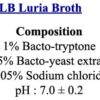Category: Lab Notes: Microbiology
Escherichia coli in Research: Timeline of Discovery and Innovation
![]()
1885: Theodor Escherich isolates and describes Bacterium coli commune (later renamed Escherichia coli) from infant stool samples. This discovery marks…
Laboratory Strains of Escherichia coli
![]()
Laboratory strains of Escherichia coli represent specialized variants that have been developed and optimized for research and biotechnology applications. These…
Natural Hosts of Plasmids Across Life Domains
![]()
Plasmids occur naturally in a variety of hosts, primarily bacteria but also archaea and eukaryotes. In bacteria, plasmids are often…
Bacteriostatic Activity Vs Bactericidal Activity
![]()
Criteria Bacteriostatic Activity Bactericidal Activity Remarks Definition Inhibits the growth and reproduction of bacteria without directly killing them Kills bacteria,…
Dysbiosis
![]()
Dysbiosis refers to an imbalance in the composition of the microbiota, the diverse community of microorganisms including bacteria, fungi, viruses,…
Preparation of Culture of Escherichia coli for Plasmid Minipreparation
![]()
A small-scale plasmid isolation procedure, the miniprep, yields a sufficient amount of plasmid for the screening of clones by restriction…
Linear Plasmid
![]()
Linear plasmids represent a unique category of extrachromosomal genetic elements that differ from the more common circular plasmids in both…
Preparation of MRS Broth
![]()
MRS broth is nutrients rich liquid medium for the cultivation of Lactobacilli. It was developed by de Man, Rogosa, and…
Protocol – Growing Large Volume of Liquid Culture of Escherichia coli for Large-Scale Plasmid Isolation
![]()
Large-scale isolation of plasmid requires a large volume of E. coli culture. Large scale plasmid isolation procedures are termed, midiprep (25 – 50 ml starting culture volume) and maxiprep (100 – 500 ml starting culture volume). A starter culture is initially prepared by inoculating a colony in a small volume (2 – 10 ml) of culture medium. Large culture volume is prepared by diluting starter culture in a ratio of 1: 100 to 1: 1000 in the growth medium.
Preparation of Lambda-agar medium and plates
![]()
Lambda-agar is nothing but a lambda broth which is solidified by agar. Agar is a solidifying agent. It melts at 85°C but melton agar stays liquid at a temperature > 40°C (this property is called hysteresis, different temperatures for melting and solidifying). This allows us to add heat-labile medium supplements such as antibiotics and vitamins and prepare solid medium. Lambda-agar solid medium is prepared by dissolving 15 g agar / liter of Lambda broth.
Preparation of TNT Medium
![]()
OVERVIEW TNT medium is a moderately rich medium. It contains tryptone, sodium chloride (NaCl) and thiamine. Tryptone provides basic nutrients…
Preparation of M9 Minimal Medium
![]()
OVERVIEW M9 minimal medium is a chemically-defined minimal growth medium, used to cultivate Escherichia coli. It is prepared by supplementing…
Escherichia coli
![]()
Escherichia coli, commonly referred to as E. coli, is a Gram-negative, facultative anaerobic bacterium that belongs to the Enterobacteriaceae family. …
Preparation of SOC (Super Optimal broth with Catabolite repression) Medium
![]()
SOC (Super Optimal broth with Catabolite repression) medium is a nutrient-rich microbial growth medium, formulated by Douglas Hanahan in 1983 (Hanahan, 1983). SOC medium is prepared without Mg++ and Glucose by dissolving 20 g bacto-tryptone, 5 g bacto-yeast extract, 2 ml of 5M sodium chloride, and 2.5 ml of 1M KCl in water to a final volume of ≈ 1000 ml (960 ml). Magnesium salts (i.e., MgSO4 and MgCl2, 10 ml each of 1M MgSO4 and 1M MgCl2) and Glucose (10 ml of 1 M Glucose) are added to the medium after autoclaving to prevent any chemical reactions and precipitation of the medium components, and degradation of Glucose.
Preparation of LB Luria Broth
![]()
LB is a rich growth medium, commonly used to grow E. coli. LB Luria Broth contains 1% Bacto-tryptone, 0.5% Bacto-yeast extract and 0.05% Sodium chloride. A 1000 ml LB Luria Broth is prepared by dissolving 10 g Bacto-tryptone, 5 g Bacto-yeast extract and 0.5 g sodium chloride in deionized water to a final volume of 1000 ml. After adjusting the pH 7.0 with 5N NaOH medium is autoclaved and stored in a cold room.

